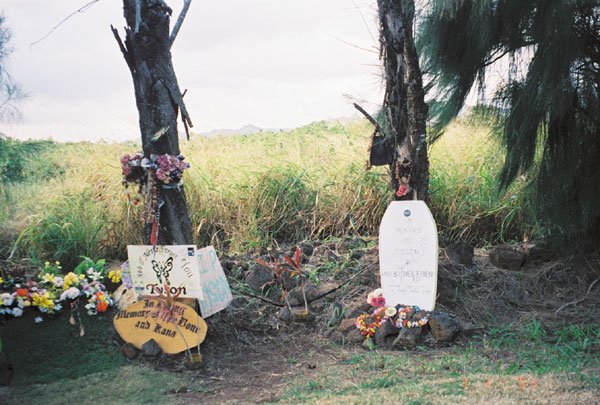We saw it during Spring Break along Poipu Road, at the periphery
of one of Kauai’s lavish resort communities. Dominated by a
surfboard, photos, tender messages, flowers, and other articles, it
was a memorial to some local young men who met a tragic fate near
that site.
We saw it during Spring Break along Poipu Road, at the periphery of one of Kauai’s lavish resort communities. Dominated by a surfboard, photos, tender messages, flowers, and other articles, it was a memorial to some local young men who met a tragic fate near that site.
This phenomenon, I’ll call it “informal roadside memorials,” is becoming increasingly common. This topic was examined recently on “Religion and Ethics Newsweekly,” the award-winning public affairs weekly series appearing on the Public Broadcasting System. (It airs locally on Mondays at midnight on KQED, Channel 9.)
According to Dr. Bob Bednar, communications professor at Southwestern University in Austin Texas, “These sites are there to mark the place where a person died in an accident and to warn others not to let it happen to them.”
The cross has long been a symbol of death in our society, dating back to the crucifixion of Jesus of Nazareth. “It’s as universal a symbol as this culture has to mark death spots.”
According to Bednar, “Roadside crosses have a couple of different origin points. Some of them started with Spanish settlement into the Southwest. Particularly in Catholic faith traditions, the cross is meant to signify the place the soul left the body before it could be consecrated – sudden deaths that were too quick to have a priest deliver the last rites.”
Of course, many cemetery graves also are marked with crosses, but this relates to the other Christian symbolism of the cross – the faith in resurrection represented by the Easter event.
Roadside shrines have become something of a portal, a place where friends and loved ones can come to communicate with the dead person. A wide array of items may be present: votive candles, photos, flowers, personal belongings, even written messages. People may come and leave something that is very personal to them, often a bond they had shared with the deceased.
As Bednar points out, in Texas these informal sites are illegal; only ones established by Mothers Against Drunk Driving are sanctioned by the state. A spokesperson at the Morgan Hill Police Department confirmed that they are also illegal on public property here in California. But she went on to say that it’s highly unlikely any police officer would enforce this law absent public complaints.
South County has several of these memorials:
n In Morgan Hill, at the southeast corner of Hill Road and Barrett Avenue stands a shrine dedicated to Jon Stewart.
n On the west side of of Monterey Highway, just north of Fitzgerald Avenue, is a memorial dedicated to both Isidero Trujillo and Patrick Pantoj. The latter victim’s birth (Aug. 11, 96) and death (July 6, 02) dates are listed.
n For several years there was a memorial to a child killed by a reckless driver at the southeast corner of East Dunne and Saddleback avenues in Morgan Hill. Apparently, this family has moved away, and the only item still attached to the fence along the street is a small Christmas tree ornament in the form of an angel.












